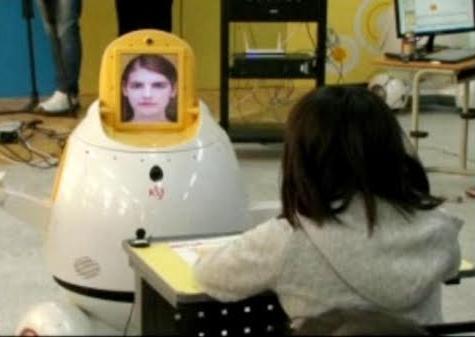 Update: This telepresence article inspired more than a few comments in LinkedIn discussion groups. With the authors’ permission, we are reposting comments made by Tandy Trower of Hoaloha Robotics, and Jim Gunderson of Gamma Two Robots.
Update: This telepresence article inspired more than a few comments in LinkedIn discussion groups. With the authors’ permission, we are reposting comments made by Tandy Trower of Hoaloha Robotics, and Jim Gunderson of Gamma Two Robots.
“For certain types of scenarios, telepresence is very useful. For example, it has enabled us to explore the surface of Mars, inspect the nuclear reactor buildings in Japan, and enable soldiers to remotely defuse bombs. However, for business and personal/consumer scenarios it is much less clear if the value proposition works. There are the arguments that Perlow suggests which are evident even in the Skype conversations that I have. The video phone concept has been around for a long time and now that we actually have the capability not all users are comfortable with a video call. Further, as you note this capability is already increasing present on our PCs, smartphones, and tablets. So it comes down more to whether you need mobility in the remote location. If you just want to check on your kids or pets, you might not need to pay what is now a premium cost for the mobility aspect, i.e. an iPhone with FaceTime or Android phone with Skype is a few hundred dollars at most, whereas the cheapest telepresence robot (if you don’t count the toys) is $6,000. Maybe this cost can be justified in the corporate/enterprise world in contrast to the cost of plane tickets, but in a home situation, it is less clear that value proposition (value and its cost) make sense by itself. Otherwise, you would be writing about how Vgo or Anybots is the next Google. If telepresence robots by themselves are going to be useful, they are going to have to come down the price of a Roomba before they might be successful.
I could also argue that driving remotely takes a bit of practice. You lose most of your peripheral vision, so driving a telepresence robot is a bit driving your car while looking through a paper tube. A good sensor system and interface can make up for this, but I’ve not seen one yet that would fit a consumer.
All that said, I would agree that telepresence may be a valuable feature, but that’s different than a “killer app”. For example, when you buy a Windows PC or a Mac you get a small suite of useful applications, but none of these really justify the purchase of the machine. It is the other applications that you run that provide that value. So telepresence, like a web browser included with the OS, might be a useful feature, but isn’t really a killer app. To get robots into the home will take much more than that. Keep in mind that the ill-fated Aibo actually delivered telepresence and it wasn’t enough. You can argue there are other reasons that Sony discontinued Aibo or that perhaps it wasn’t the best platform for telepresence, but that capability was not enough. Neither was it enough for iRobot to proceed with the telepresence robot, ConnectR, that they demoed at CES and there were earlier models and designs that also they never brought to the market. Ava may be better suited as a design, but there are other issues here.
Finally, what the industry is still missing is the user experience. Roomba succeeded in part because the value you get for its cost is within the consumer threshold (whereas Aibo did not), but also because Roomba’s user interface is very simple–i.e. a couple of buttons. Too much of the emerging robotics industry is ignoring the importance of the user experience, even though this has clearly been demonstrated by Apple as the factor that most distinguishes their success in the smartphone and tablet industry. The iPhone came late to the party and swept the industry not so much because of it offered a ton more features that users were waiting for, but because it has a UI that was superior. Likewise, despite pundits early prognostications of the failure of the iPad because it lacked a keyboard and seemed a poor platform for productivity applications, they succeeded in creating a new evolved platform that users loved for its user experience, even though it did not offer the same capabilities as Microsoft demonstrated in their tablet PC design. The robotics industry needs to wake up to importance of the UI design.”
Posted by Tandy Trower
“I agree that tele-presence have some strong value in certain situations. I was talking with an engineer who had been flying from the US to Australia to consult on a design. He would have loved to have a telepresence rig at the other end, and it would have been really cost effective.
However, the real win with a robot should be that it frees people up. It acts as a force multiplier. In most situations, if a person has to control the robot, second by second, to get the job done, there is limited marginal value. We focus on the “three D’s’ Jobs that are Dangerous, Dirty, or Dull. In these situation the marginal value goes up significantly. If you can have a robot operate ‘hands free’ to do an eight hour shift, and not require hands on a joy-stick to make it happen, then there is real value.
Of, course that requires robots that can operate for a full shift without supervision. In an industrial setting this has become routine, but outside the factory floor, it gets tricky. I spent most of the last few weekends observing our security robot prototype patrolling a working parking garage. Since I was just watching the ‘bot, it gave me some time to think about lab projects versus products: http://wp.me/p1zQAM-g
So, I don’t think tele-presence will be the killer app. The killer app will be robots reliably doing boring jobs, on their own. We are aiming at the night time security guard: http://www.gamma-two.com/robots.html”
Posted by Jim Gunderson
Original post: Researchers use telepresence capabilities in Operator Control Units to increase the speeds of UGVs. In addition, some think that telepresence may be a “killer app” i.e., it may be so attractive that the average person must simply buy a robot. Click here to read about it.







I see it going the other way. APPS are so “killer” they’ll require every appliance maker to make their goods “app-compatible” (a new word APPatible(TM) will be coined – by me. Appatiblility(TM) will ensure faults feed cell phones.
I totally agree with the article, telepresence might be a plus and could be exploited in some useful way in the future but in itself it’s far from being a selling point when it comes to things other than communication. A robot doing its own job without supervision would be a real winner, although I think it will take some time before we come to that, at least on a bigger scale.